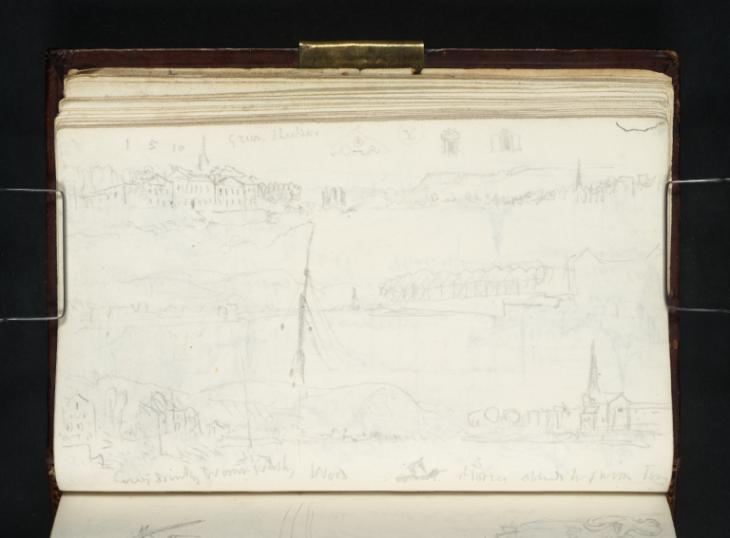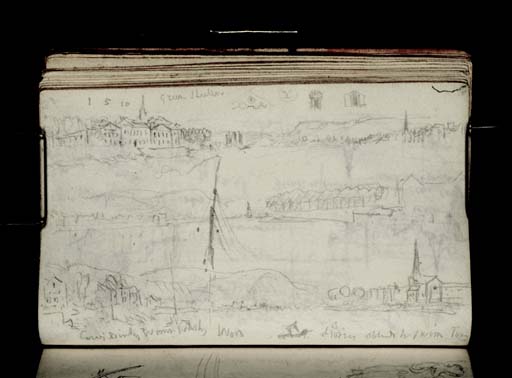Joseph Mallord William Turner Three Meuse Views, possibly the Chateau Cockerill at Seraing 1824
Image 1 of 2
Joseph Mallord William Turner,
Three Meuse Views, possibly the Chateau Cockerill at Seraing
1824
Joseph Mallord William Turner 1775–1851
Folio 28 Verso:
Three Meuse Views, possibly the Chateau Cockerill at Seraing 1824
D19607
Turner Bequest CCXVI 28 a
Turner Bequest CCXVI 28 a
Pencil on white wove paper, 78 x 118 mm
Watermark ‘smith & [allnut] | 18[22]’
Inscribed in pencil by Turner ‘1’, ‘5’, ‘10’, ‘Green Shutters’ top left to top centre; ‘Cows drinking’, ‘Women washing’, ‘[...]ord’, ‘Horses obliged to Swim’, ‘Ferry’ bottom, from left to right
Watermark ‘smith & [allnut] | 18[22]’
Inscribed in pencil by Turner ‘1’, ‘5’, ‘10’, ‘Green Shutters’ top left to top centre; ‘Cows drinking’, ‘Women washing’, ‘[...]ord’, ‘Horses obliged to Swim’, ‘Ferry’ bottom, from left to right
Accepted by the nation as part of the Turner Bequest 1856
References
1909
A.J. Finberg, A Complete Inventory of the Drawings of the Turner Bequest, London 1909, vol.II, p.670, as ‘Three views on river’.
1991
Cecilia Powell, Turner’s Rivers of Europe: The Rhine, Meuse and Mosel, exhibition catalogue, Tate Gallery, London 1991, p.40 note 11 [p.60].
2005
Peter Ackroyd, J.M.W. Turner, Brief Lives, London 2005, p.108.
Finberg and Cecilia Powell catalogue these sketches as three anonymous views on the Meuse. The appearance of the large building in the uppermost sketch, however, could suggest that Turner depicts Seraing and its Chateau, which, at the time of the artist’s visit, was the residence of the industrialist John Cockerill (see Tate D19606; Turner Bequest CCXVI 28). Formerly the summer palace of the Prince-Bishoprics of Liège, this sprawling eighteenth-century chateau is situated right on the banks of the Meuse and was once surrounded by tree-lined promenades and lush gardens. The same tree-lined avenue appears to be depicted in the central drawing at right. A church with a spire lies within the palace complex and can be seen in the drawing adjacent to Turner’s inscription ‘green shutters’ and again in the lowermost sketch at bottom right. This is the Eglise Primaire de l’Assomption de la Vierge. The small details above the top sketch may be cursory recordings of designs Turner saw on the façade or exterior pediment of the Chateau Cockerill.
The artist’s jottings written parallel to the gutter of the sketchbook reveal what he saw at the river’s edge: ‘women washing’, ‘cows drinking’, where the ‘ferry’ is caught, and a note on ‘horses obliged to swim’ across the Meuse. This final annotation ‘undoubtedly’ refers to Turner’s own travel experience, according to Cecilia Powell, because ‘at various places between Liège and Namur’ horses were employed to pull boats and barges from the middle of the river, ‘a dangerous task for both horse and rider since the river bed was full of holes’.1 Turner may have made a rough sketch of this procedure at the very bottom centre of the page next to the inscription itself, though the figure may also be a boatman.
The mast and rigging of a riverboat drawn on the opposite folio (Tate D19608; Turner Bequest CCXVI 29) is continued on this page at centre left.
Alice Rylance-Watson
February 2014
How to cite
Alice Rylance-Watson, ‘Three Meuse Views, possibly the Chateau Cockerill at Seraing 1824 by Joseph Mallord William Turner’, catalogue entry, February 2014, in David Blayney Brown (ed.), J.M.W. Turner: Sketchbooks, Drawings and Watercolours, Tate Research Publication, April 2015, https://www


